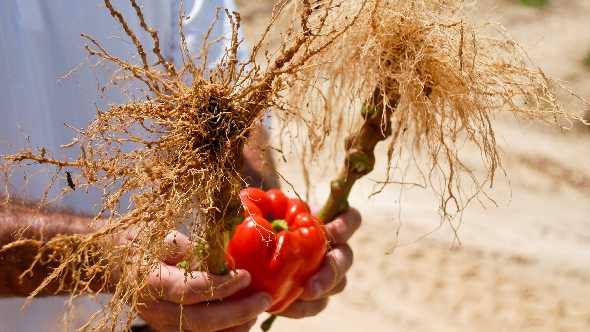New Product Takes Aim At Nematodes

An untreated bell pepper on the left compared to a NIMITZ-treated plant on the right. Photo courtesy of ADAMA
Growers battling nematodes have a new quiver in their arrow with the registration of NIMITZ (fluensulfone, ADAMA). That’s welcome news as pest levels have been on the rise in recent years in the absence of methyl bromide.
According to Herb Young, ADAMA brand manager, NIMITZ is a unique mode of action and an entirely new chemical classification. The federal registration has been approved on cucurbits (cucumbers, watermelons, cantaloupe, and squash) and fruiting vegetables (tomatoes, peppers, and eggplants).
“NIMITZ exemplifies the conceptual change we made as a company when we became ADAMA (formerly Makhteshim Agan),” says Young. “Our mission is to provide simplicity to agriculture and NIMITZ fits that bill. The simplicity will stand out with growers. The application of NIMITZ is either pre-plant incorporation like what they are familiar with some herbicides. Or, even easier than that, growers can apply the product through their drip irrigation. In drip, you apply the product seven days or more before the transplants are put in the bed. The limitation with fumigant nematicides is they require 21 days before planting, so this gives growers a little more flexibility when they need to put the product out.”
Safety Profile
Young says the safety profile of NIMITZ is a key element in making it a simplified product.
“It comes with a ‘caution’ signal word, which is EPA’s safest category,” he says. “There is a zero re-entry interval and the personal protective equipment is only gloves and long sleeves. There is no buffer zone, which is allowing some growers to retrieve land that was lost to buffers. Since it is a contact material, there is no fumigant management plan. And, there is no applicator training required.”
Methyl Bromide Back-Up
Young says NIMITZ will be a useful alternatives to methyl bromide.
“Replacing methyl bromide has been a very complicated task for the agricultural industry,” he says. “Because methyl bromide did so many things, it has generally taken a fungicide, herbicide, and nematicide to replace it. This is a perfect replacement of the nematicide component, so NIMITZ is one piece of the puzzle. There are a lot of people working very hard to help solve those other problem areas.”
Young says NIMITZ is effective against all nematode species, including root-knot, which is a big problem for vegetables in the Southeast.
“Many of the nematicides historically have only suppressed the nematode,” he says. “They suspend the nematode for a week or 10 days. But, when the product is gone, the nematodes will rejuvenate. NIMITZ is lethal to nematodes. Within 48 hours, it kills all stages of nematodes.
“You push NIMITZ through the soil with water. It is not like a fumigant that is pushed through the air pockets. You push it to the zone where you want the roots to develop with irrigation or rainfall. And, we have seen pretty good residual activity, which also distinguishes it from fumigants. We have seen activity up to 45 days.”
Young adds the product will have a particularly good fit in the Homestead area where fumigant nematicides are not allowed because of the calcareous soil type there.
“NIMITZ will be a great fit in the area with an effective nematicide they have not had since the loss of methyl bromide,” he says.
Next Crops Up
ADAMA will submit their second tier of crops for registration in the first quarter of this year, and it will include strawberries, potatoes, carrots, brassicas, leafy vegetables, and tobacco. EPA generally runs on an 18-month timeline for approval after submissions are made.
Tier three crops will include citrus, nut crops, pome, grapes, and peanuts. The later tier of crops are about three years out from receiving EPA approval.










